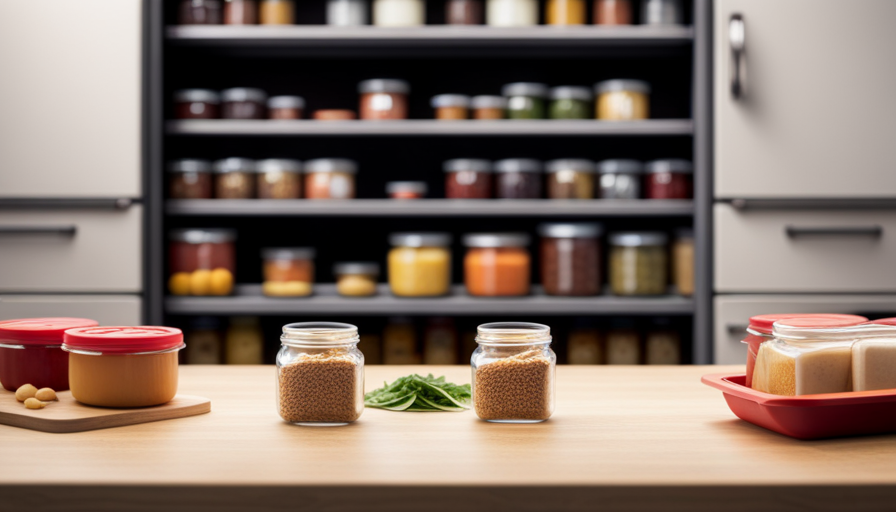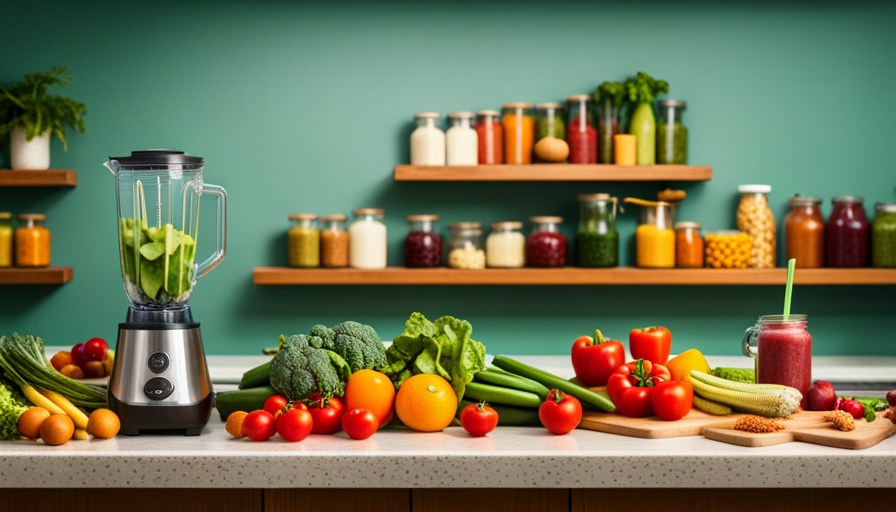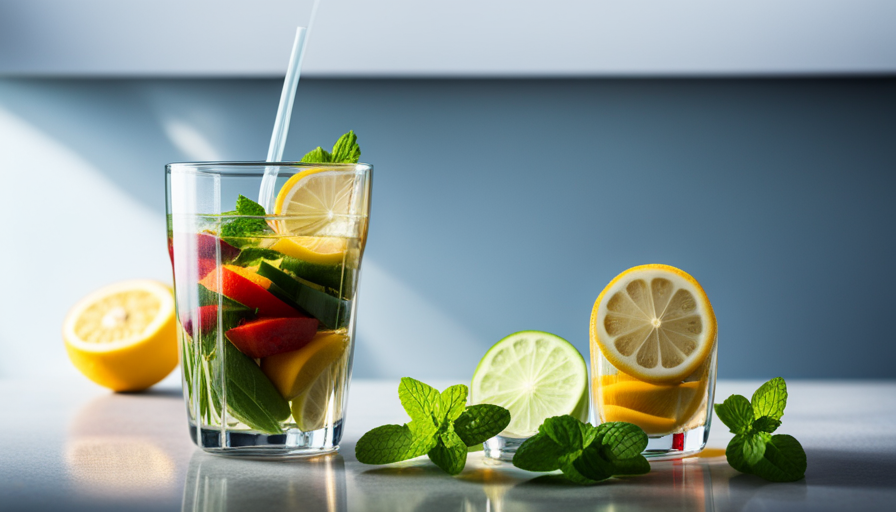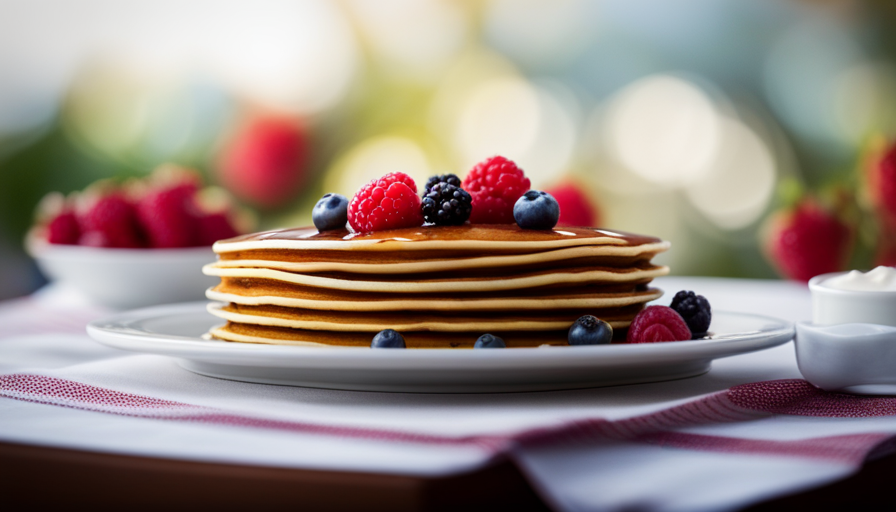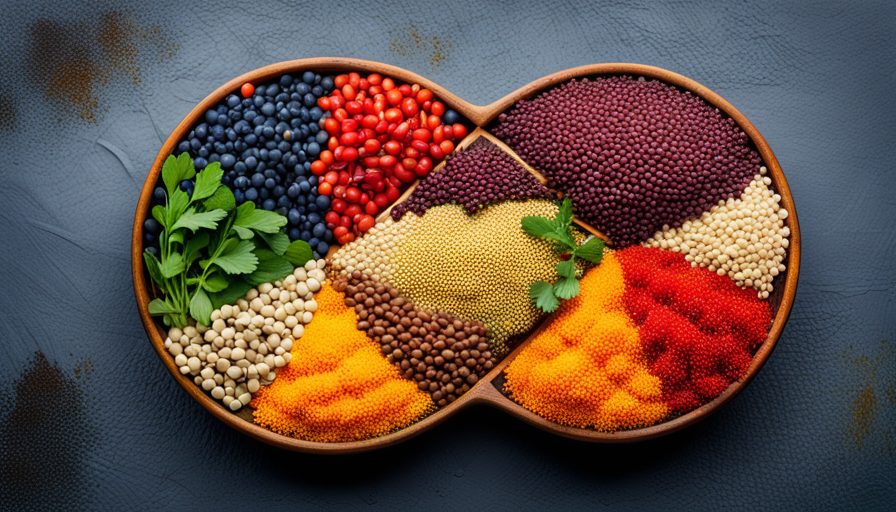Envision a magnificent orchestra, where every instrument contributes flawlessly to a majestic sound creation. Similarly, in the culinary realm, preserving food properly is an art that demands meticulous coordination to guarantee your dishes are both safe and flavorful.
When it comes to raw and cooked food, it is crucial to separate them like a conductor separates the different sections of an orchestra. This separation not only prevents cross-contamination but also maintains the integrity of each ingredient.
In this article, we will explore the importance of separating raw and cooked food and provide you with practical tips on how to store them properly. From using different containers and cutting boards to labeling and dating, we will guide you through the steps to maintain the freshness and quality of your culinary creations.
So, let’s delve into the world of food storage and discover the secrets to keeping your raw and cooked ingredients in perfect harmony.
Key Takeaways
- Store raw food (meat, seafood) in leak-proof containers on the bottom shelf of the refrigerator.
- Use separate cutting boards and utensils for raw and cooked food, preferably different colored cutting boards.
- Label containers to differentiate between raw and cooked food and to maintain freshness and safety.
- Practice proper handwashing techniques before and after handling raw foods and regularly clean and sanitize pantry shelves to reduce the risk of cross-contamination.
Understanding the Importance of Separating Raw and Cooked Food
You need to understand why it’s crucial to separate your raw and cooked food. It’s a simple step that can prevent foodborne illnesses and keep your meals safe and delicious.
The importance of proper food storage cannot be stressed enough, especially when it comes to raw and cooked food. When these two types of food come into contact, there is a high risk of cross contamination in the kitchen.
Cross contamination occurs when harmful bacteria from raw food is transferred to cooked food, leading to foodborne illnesses such as Salmonella, E. coli, or Campylobacter. These illnesses can cause symptoms like nausea, vomiting, diarrhea, and in severe cases, even hospitalization.
By storing raw and cooked food separately, you minimize the chances of these bacteria spreading and causing harm. To ensure proper separation, always keep raw food, such as raw meat, poultry, and seafood, in leak-proof containers on the bottom shelf of your refrigerator. This prevents any juices from dripping onto other foods. Additionally, use separate cutting boards and utensils for raw and cooked food to avoid cross contamination during preparation.
Understanding the importance of separating raw and cooked food is crucial for maintaining food safety. By following proper food storage practices and preventing cross contamination, you can enjoy safe and delicious meals without the worry of foodborne illnesses.
Keeping Raw and Cooked Food in Separate Containers
To ensure the freshness and flavor of your meals, it’s best to use different containers for your uncooked ingredients and prepared dishes. This not only helps in keeping the flavors intact but also maintains the safety of your food.
Properly separating raw and cooked food during storage is crucial to prevent cross-contamination and reduce the risk of foodborne illnesses. Here are three important points to consider when it comes to separate storage and food safety:
-
Use separate containers: It’s essential to have designated containers for raw and cooked food. Keep raw ingredients like meat, poultry, and seafood in leak-proof containers to prevent any juices from contaminating other foods. Similarly, store your cooked dishes in separate containers to avoid any potential transfer of bacteria.
-
Label your containers: Ensure that you clearly label your containers to differentiate between raw and cooked food. This will help you easily identify and grab the right container when you’re ready to cook or serve your meals.
-
Store in appropriate locations: Raw food should always be stored on lower shelves or in separate compartments of the refrigerator to prevent any drips or spills from contaminating other foods. Cooked food, on the other hand, should be stored at the top to avoid any potential contamination from raw food.
By following these guidelines for separate storage and food safety, you can ensure that your meals are not only delicious but also safe to consume.
Using Different Cutting Boards for Raw and Cooked Food
When it comes to keeping your ingredients fresh and your meals safe, it’s important to remember that using different cutting boards for raw and cooked items is key.
One of the best ways to ensure proper food handling is by using different colored cutting boards for raw and cooked food. This simple practice can help prevent cross-contamination and reduce the risk of foodborne illnesses.
Using different colored cutting boards is a visual reminder that you need separate surfaces for raw and cooked items. For example, you can designate a red cutting board for raw meat and a green cutting board for cooked vegetables. This way, you can easily distinguish between the two and avoid any mix-ups.
Proper food handling is crucial to prevent the spread of harmful bacteria. When you use the same cutting board for raw and cooked food, there is a higher chance of cross-contamination. Bacteria from raw meat or poultry can easily transfer to your cooked food, leading to food poisoning. By using different cutting boards, you can minimize this risk and keep your meals safe for consumption.
Remember to always wash your cutting boards thoroughly with hot, soapy water after each use. This will help remove any lingering bacteria and keep your cutting boards clean and safe for future use.
By following these simple steps and using different colored cutting boards, you can ensure proper food handling and enjoy delicious, safe meals.
Storing Raw and Cooked Food at Different Temperatures
Properly storing your ingredients at different temperatures is crucial for maintaining their freshness and minimizing the risk of contamination. When it comes to storing raw and cooked food, it’s important to keep them separate to avoid cross-contamination. Storing raw and cooked food together can lead to the transfer of harmful bacteria, which can cause foodborne illnesses.
To prevent cross-contamination, it’s recommended to store raw and cooked food in separate containers or wrap them separately. Raw food should be stored in leak-proof containers on the bottom shelf of the refrigerator to prevent any juices from dripping onto cooked food or other ready-to-eat items.
It’s also important to note that raw meat, poultry, and seafood should be stored at temperatures below 40°F (4°C) to slow down bacterial growth. On the other hand, cooked food should be stored at temperatures above 140°F (60°C) to keep it out of the "danger zone" where bacteria multiply rapidly.
By following these storage guidelines, you can reduce the risk of cross-contamination and ensure the safety of your food. Remember to always practice good hygiene, such as washing your hands before and after handling raw food, to further minimize the risk of contamination.
Properly Labeling and Dating Containers
By labeling and dating containers, you can ensure that your meals are safe and fresh, giving you peace of mind. Properly labeling and dating containers is an essential step in ensuring the proper storage of your food. Here are three reasons why it’s important to label and date your containers:
-
Prevents confusion: Labeling your containers with the contents and date of preparation helps you avoid any confusion regarding what’s inside. This is especially important when you have multiple containers in the fridge or freezer. By clearly labeling your containers, you can easily identify and select the appropriate meal for consumption.
-
Promotes food safety: Proper labeling allows you to keep track of how long the food’s been stored. This is crucial for preventing the consumption of food that may have exceeded its recommended storage time. By dating your containers, you can easily identify which meals need to be consumed first, reducing the risk of foodborne illnesses.
-
Reduces waste: By having a clear label indicating the date of preparation, you can easily determine if the food’s still safe to eat. This helps in reducing food waste as you can make informed decisions about which items should be consumed first.
Incorporating these simple labeling and dating practices into your food storage routine ensures that you maintain the freshness and safety of your meals. So, take a moment to label and date your containers, and enjoy peace of mind knowing that your food’s stored properly.
Avoiding Cross-Contamination in the Refrigerator
To keep your fridge organized and prevent any mix-ups, make sure you avoid cross-contamination by following these simple tips. One of the most important things you can do to prevent cross-contamination is to separate raw and cooked food in the refrigerator. Raw foods, such as meat, poultry, and seafood, can contain harmful bacteria that can spread to other foods if not stored properly.
To help you visualize the proper way to store raw and cooked foods, here is a table that illustrates the do’s and don’ts:
| DO Store Raw Food Here: | DON’T Store Raw Food Here: |
|---|---|
| Bottom shelf | Above ready-to-eat foods |
| Sealed containers | Uncovered or open plates |
| Labeled and dated | Directly on refrigerator shelves |
By following this table, you can prevent cross-contamination and ensure that harmful bacteria does not spread to your cooked foods. Additionally, it is crucial to practice proper handwashing techniques before and after handling raw foods. This helps eliminate any bacteria that may be present on your hands and reduces the risk of contamination.
Remember, preventing cross-contamination in the kitchen starts with proper storage and handling of raw foods, along with diligent handwashing. By following these tips, you can keep your fridge organized and your food safe to consume.
Keeping Raw and Cooked Food on Separate Shelves in the Pantry
In order to maintain food safety in the pantry, it’s important to remember the saying, ‘out of sight, out of mind,’ when it comes to keeping raw and cooked items on different shelves. Properly separating storage is crucial to prevent cross-contamination and ensure the safety of your food.
When organizing your pantry, designate specific shelves for raw and cooked food. This will help you visually distinguish between the two and reduce the risk of accidentally mixing them. Raw food, such as raw meat, poultry, and seafood, should be stored on lower shelves to prevent any potential drips or leaks from contaminating cooked items.
To further ensure separation, consider using different colored containers or labels for raw and cooked food. This will provide a clear visual cue and make it easier to identify which items belong to each category. Additionally, keep raw food in sealed containers or bags to prevent any potential bacteria from spreading to other items in the pantry.
Regularly clean and sanitize your pantry shelves to maintain a hygienic environment. This will help eliminate any lingering bacteria and reduce the risk of cross-contamination. By following these guidelines for separate storage and pantry organization, you can ensure the safety and quality of your food.
Using Separate Utensils for Handling Raw and Cooked Food
When handling both types of ingredients, remember to utilize distinct utensils to maintain the highest level of food safety. Using separate utensils for handling raw and cooked food is essential in preventing cross-contamination and ensuring the safety of your meals. This practice helps to reduce the risk of harmful bacteria and foodborne illnesses.
By using separate utensils, you can prevent the transfer of bacteria from raw food to cooked food. This is especially important when it comes to utensils that come into direct contact with the food, such as knives, cutting boards, and spatulas. It is recommended to have designated utensils for raw food and separate ones for cooked food.
To illustrate the importance of using separate utensils, here is a table that showcases the potential risks of cross-contamination:
| Raw Food | Cooked Food |
|---|---|
| Salmonella | E. coli |
| Campylobacter | Listeria |
| Clostridium perfringens | Norovirus |
| Shigella | Hepatitis A |
| Staphylococcus aureus | Botulism |
As you can see, cross-contamination can lead to various foodborne illnesses that can be serious or even life-threatening. By using separate utensils for handling raw and cooked food, you can significantly reduce the risk of these dangerous bacteria and viruses contaminating your meals.
Remember, practicing proper food handling, including using separate utensils, is crucial for maintaining food safety in your kitchen.
Cleaning and Sanitizing Surfaces After Handling Raw Food
After handling ingredients, make sure you clean and sanitize surfaces to prevent the spread of harmful bacteria and reduce the risk of foodborne illnesses. Did you know that a study found that 75% of kitchen surfaces still contained traces of bacteria even after being wiped down?
To ensure proper cleaning and sanitizing of surfaces, follow these steps:
-
Use hot, soapy water: Start by washing the surface with hot, soapy water to remove any visible dirt or food residue. This will help eliminate a significant amount of bacteria.
-
Apply a disinfectant: After washing, apply a suitable disinfectant to kill any remaining bacteria. Look for disinfectants specifically designed for kitchen surfaces, as they’re formulated to be effective against foodborne pathogens.
-
Let it sit: Allow the disinfectant to sit on the surface for the recommended contact time specified on the product label. This will ensure that it effectively kills all bacteria present.
-
Rinse thoroughly: After the recommended contact time, rinse the surface thoroughly with clean water to remove any residue from the disinfectant.
-
Dry completely: Finally, make sure the surface is completely dry before using it again. Moisture can promote bacterial growth, so drying is essential to prevent contamination.
By following these cleaning and sanitizing practices, you can effectively remove bacteria from kitchen surfaces and create a safer environment for food preparation.
Educating Yourself and Others on Food Safety Practices
Now that you understand the importance of cleaning and sanitizing surfaces after handling raw food, it’s time to delve into the next crucial step in food safety: educating yourself and others on food safety practices. By being knowledgeable about proper food handling and storage techniques, you can significantly reduce the risk of foodborne illnesses.
One effective way to educate yourself is by attending food safety courses or workshops offered by reputable organizations. These courses cover topics such as safe food handling, proper cooking temperatures, and preventing cross-contamination. Additionally, you can stay updated on the latest food safety guidelines by regularly visiting trusted websites or reading books written by food safety experts.
Equally important is sharing your knowledge with others. By teaching your family, friends, or coworkers about food safety practices, you can create a safer environment for everyone. Use everyday situations to highlight the importance of separating raw and cooked food, proper handwashing techniques, and the dangers of consuming undercooked meat or poultry.
To emphasize the key points of food safety education, consider using the following table:
| Food Safety Education Tips | Preventing Foodborne Illnesses |
|---|---|
| Attend food safety courses | Proper food handling |
| Stay updated on guidelines | Safe cooking temperatures |
| Teach others about food safety | Avoid cross-contamination |
| Emphasize importance of handwashing | Dangers of undercooked meat |
Remember, knowledge is power when it comes to preventing foodborne illnesses. By educating yourself and others, you can make informed decisions that promote food safety in your everyday life.
Frequently Asked Questions
Can I store raw and cooked food in the same container if it’s covered?
No, it’s not recommended to store raw and cooked food together, even if it’s covered. Following proper food storage guidelines is crucial to prevent cross-contamination and the spread of harmful bacteria.
Raw and cooked foods have different storage requirements and should be kept separate to minimize the risk of foodborne illnesses. It’s best to store raw and cooked food in separate containers to maintain their integrity and ensure food safety.
Is it necessary to use different cutting boards for raw and cooked food if I wash them thoroughly?
Using the same cutting board for both raw and cooked food, even if washed thoroughly, can still pose cross-contamination risks. While washing helps remove visible dirt and bacteria, microscopic traces can remain.
To prevent this, it’s best to use different cutting boards for raw and cooked food. This is one of the recommended practices for minimizing cross-contamination risks. By implementing this simple step, you can ensure the safety and hygiene of your meals.
Can I store raw and cooked food at the same temperature if they are wrapped separately?
To prevent cross-contamination and ensure food safety, it’s crucial to store raw and cooked food at different temperature requirements. Raw food should be stored at temperatures below 40°F (4°C) to prevent bacterial growth. Cooked food, on the other hand, should be kept at temperatures above 140°F (60°C) to maintain its quality.
Wrapping them separately is a good practice, but it’s equally important to store them in separate areas of the refrigerator to minimize the risk of cross-contamination.
Remember, proper storage is key to keeping your food safe and delicious.
How long can I keep labeled and dated containers of raw and cooked food in the refrigerator?
To ensure food safety, it’s crucial to properly label and date containers of raw and cooked food in the refrigerator. This not only helps you keep track of the storage time but also prevents cross-contamination. Use clear labels with the date of preparation to easily identify the freshness of the food.
Additionally, store raw and cooked food separately to avoid any potential bacterial growth. By following these practices, you can confidently keep labeled and dated containers of raw and cooked food in the refrigerator for up to three to four days.
Is it safe to keep raw and cooked food on the same shelf in the pantry if they are in sealed packages?
It’s not safe to keep raw and cooked food on the same shelf in the pantry, even if they’re in sealed packages. While sealed packages may provide some level of protection, there’s still a risk of contamination. Raw and cooked food can have different shelf lives, and keeping them together increases the chances of cross-contamination.
Bacteria from raw food can potentially contaminate the cooked food, leading to foodborne illnesses. It’s best to store raw and cooked food separately to minimize the risk of contamination.
Can Raw and Cooked Food Be Stored Together in a Raw Food Kitchen?
When preparing raw food kitchen essentials, it’s crucial to store raw and cooked food separately to prevent cross-contamination. Keep raw ingredients like meat, seafood, and eggs in a designated area away from cooked foods to maintain food safety. Use separate containers and utensils to further reduce the risk of contamination.
What is the best way to store raw and cooked food separately?
When it comes to raw food meal preparation, the best way to store raw and cooked food separately is to use airtight containers or resealable bags. Keep raw meats on the bottom shelf of the refrigerator to prevent any drippings from contaminating other foods. This will help prevent cross-contamination and ensure food safety.
Conclusion
In conclusion, remember to separate and store raw and cooked food to ensure food safety and prevent cross-contamination. By keeping them in separate containers, using different cutting boards and utensils, and storing them at different temperatures, you can reduce the risk of foodborne illnesses.
Properly labeling and dating containers, keeping them on separate shelves, and cleaning surfaces after handling raw food are also important steps. By educating yourself and others on food safety practices, you can become a savvy and sanitary chef! So, stay smart and separate for a safer and scrumptious culinary experience.

